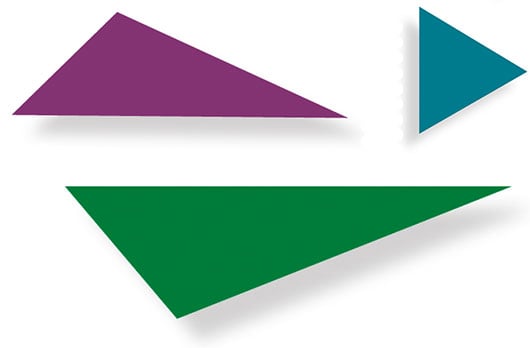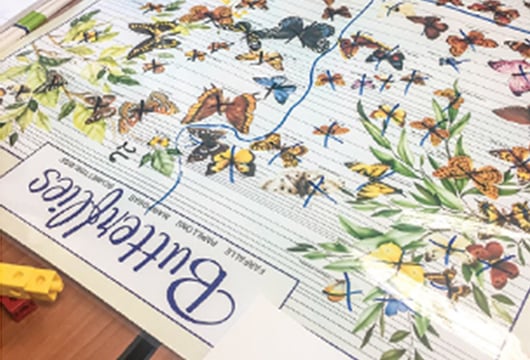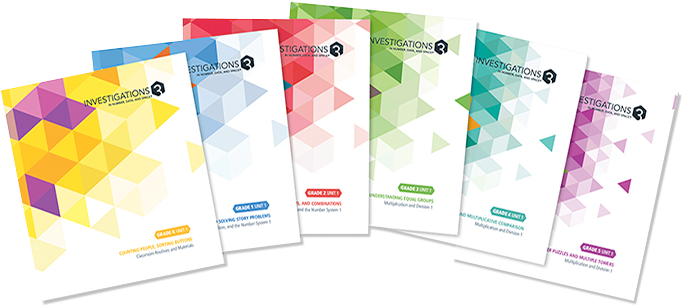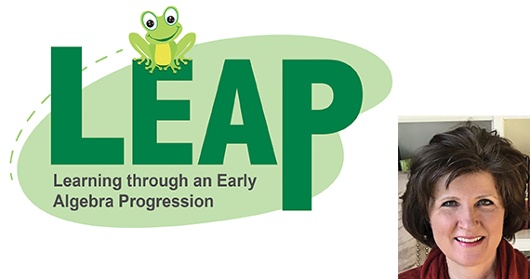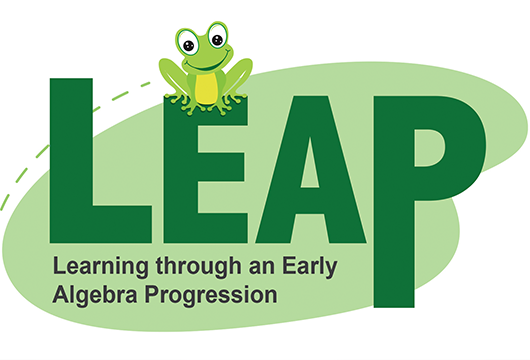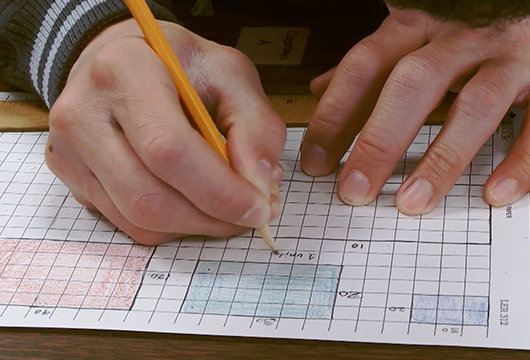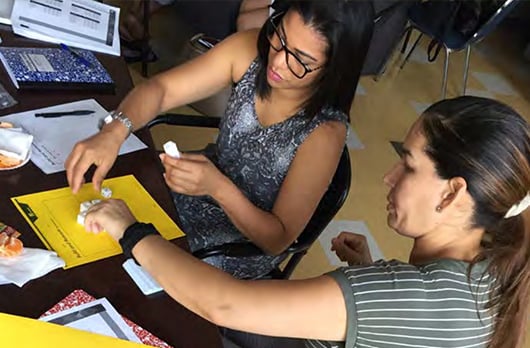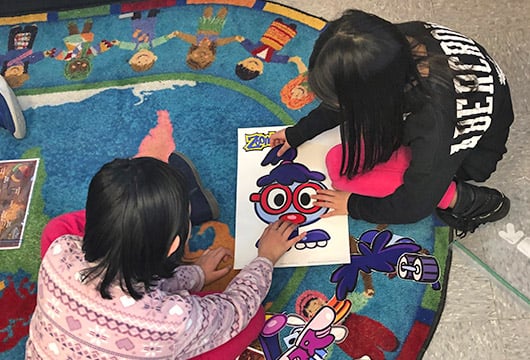TERC Blog
If You Know the Answer, Don’t Ask the Question
Open-ended questions and math conversation
Triangles, triangles, triangles … big ones, small ones, fat ones, thin ones. It’s triangle month at El Gato Early Reading Readiness (ELR) program, a pop-up preschool that caregivers attend alongside their children1. All month long, children find triangular objects, move their bodies to form triangles, and sing songs about triangles. Today, as children use foam stickers in geometric shapes to make collages, Jasmine, the program facilitator, circulates to show caregivers how to support children’s math learning.
First, Jasmine approaches 4-year-old Ana and her grandmother, who are choosing stickers. Jasmine points to a scalene triangle (with each side a different length), and asks Ana, “How can you tell this is a triangle?” (Figure 1). Ana picks up the triangle and looks closely. Slowly, she traces each edge with her index finger and says, “Because … three straight sides,” and then she touches each vertex and says, “three corners.”

Ana’s grandmother takes Jasmine aside and asks, “Why did you tell her it’s a triangle? You gave away the answer!” Jasmine explains that the “answer” to her question is about properties of triangles; Ana’s answer shows that she recognizes that a solid figure with three straight sides and three angles is a triangle, even if it doesn’t look like a “typical” triangle.
Next, Jasmine approaches Marco, also 4, and his father. She points to a scalene triangle and poses the same question, “How can you tell this is a triangle?” Marco replies with a confident grin, “You’re tricking me. That’s not a triangle!” When Jasmine asks him to explain, he tells her it’s pointed the wrong way and it’s too long. He finds an equilateral triangle among his foam stickers, lays it point-upward and announces, “This is a triangle!” (Figure 2). Seizing a learning moment, Jasmine asks, “How are those two shapes the same?” Marco notes that both have three sides and three corners, “but, it doesn’t look like a triangle … maybe if I turn it like the other one … .”
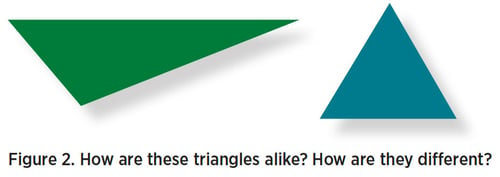
As Marco continues to mull over the two shapes, Jasmine recognizes that Marco’s ideas of what constitutes a triangle are developing; he understands that they have three sides and three angles, but his conception is not sufficiently robust to consistently encompass triangles with unfamiliar proportions or orientations.
1El Gato is a pseudonym.
Open-ended questions spark math conversations
Educators, researchers, and policymakers underscore the value of engaging in conversation with young children to uncover their mathematical thinking and to foster their mathematical learning, curiosity, and confidence (Ginsburg, 2019; NAEYC and NCTM, 2010; NCTM, 2019; Woods, 2017). Open-ended questions can spark conversations and help children gain the deep mathematical understanding they need for later school success: as children explain their thinking, they learn to verify their ideas for themselves, rather than rely on adults to tell them if they are correct; they come to explore inconsistencies and contradictions in their thinking, as Marco did; and, they learn that their math thinking matters. Open-ended questions can also help adults get a sense of what children understand. If, instead of asking open-ended questions, Jasmine had held up a triangle and asked, “what shape is this?” or requested that children identify a triangle from a group of shapes, she wouldn’t have gathered as rich a picture of children’s understandings. A correct answer could even be a lucky guess, rather than a reflection of what children know.
Yet, coming up with open-ended math questions is often a challenge. Most adults learned math in a format that centers on closed questions, whether finding the answer to an arithmetic problem, determining which of two amounts is larger, or identifying a shape correctly. In this traditional approach, math answers consist of a number or word, rather than an explanation.
“I’ve definitely grown by asking [the questions in the activities] to make sure the kids are getting the concepts. The questions showed me that ‘good’ math questions can be about thinking, rather than about finding the answer.”
—ELR FACILITATOR ON CHANGES IN HER OWN LEARNING
Three steps to open-ended math questions
In our work creating math curriculum and professional development for ELR programs, we help facilitators and caregivers come to see math as a subject in which answers can be about how you know or what you notice. Open-ended math questions are at the core of our approach.
Below, we share three strategies that we’ve found particularly successful for helping adults (including the many with a history of math anxiety) become more comfortable and confident with open-ended math questions.
Plan activity-specific open-ended questions in advance.
For adults just learning to pose open-ended math questions, a concrete starting point can be invaluable. We provide activity pages with open-ended questions (shown with speech bubbles) for adults to ask children, as a way to prompt mathematical thinking and discussion. For instance:
Discussion questions for the activity, Hands Together, (Figure 3) engage children in comparing hands with an adult caregiver. As they explore and talk over similarities and differences, they naturally discuss amounts, shapes, and sizes.
When prompted to compare hands, Lucas, age 5 explained, “We both have five fingers. Yours are longer and wider than mine.”
Discussion questions for the activity, Mix and Matchup (Figure 4) engage children in finding and explaining meaningful ways of comparing amounts.
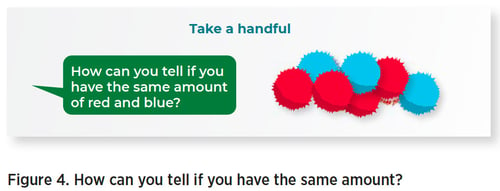
To compare amounts, Sofia, age 3, paired up her three blue and four red pompoms and noted that one red didn’t have a partner (Figure 5, left). When prompted to show a second way, she distributed her pompoms on the corners of a piece of paper, and explained that there were more red because one corner had a red pompom but not a blue one (Figure 5, below).

Use open-ended question-starters.
Many math learning opportunities happen in the moment. To help adults build their repertoire of open-ended math questions so they can better seize those math moments, we encourage them to focus on one question-starter each week.
How do you know … For instance, “How do you know 3 + 2 is 5?”, “How do you know this one is longer?”, “How do you know this is a square?”. To answer, children must show or explain their thinking.
How are they the same? How are they different? Look for opportunities for children to compare two things: two patterns, two shapes, or two sets. You’ll engage them in looking closely, noticing, and describing.
How did you … “How did you make this pattern?” “How did you make your block tower?” “How did you make sure both paper dolls are the same size?” Even if children are not able to fully articulate their problem-solving processes, they’ll still learn that their problem-solving approaches matter.
“Using the questions, I saw for myself how much they help children learn. [Misha] placed something wrong in a sorting activity. My first thought was to ask her to check if that was correct—basically, I’d be telling her she’s wrong. Instead, I asked her how the groups were the same and different, like it said on the sheet, and she self-corrected. If I had stepped in quickly to evaluate her, she would not have had the opportunity to learn from her own mistakes.”
—ELR FACILITATOR ON USING OPEN-ENDED QUESTIONS WITH CHILDREN
Ask yourself these two questions.
As facilitators and caregivers develop their own open-ended math questions, we encourage them to consider two things:
Does this question engage children in explaining their thinking? To respond to your question, children should have to explain or demonstrate their ideas.
Do I already know the answer to this question? If you know the answer, find a way to turn the question around, so you’re asking children to explain how they know what the answer is.
If you don’t already know the answer, you’ll learn something new!
Open-ended questions make math with young children a learning experience for everyone. They can spark children’s thinking, curiosity, and reflection; they also offer adults a window into children’s thinking. If you don’t already know the answer, you’ll learn something new—about how children think, about ways that children see the world, or about something else entirely unexpected.
This article is based on our Make Connections project, a collaborative, multi-year effort to develop, evaluate, and nationally disseminate an English/ Spanish math program for young children and their caregivers. The program includes interdisciplinary adult-child math units for ages 0-2 and ages 3-5, story time connections, professional development materials, and information for caregivers on ways to promote young children’s mathematical development through everyday conversation and open-ended questions.
Make Connections materials convey math concepts and activity steps visually, in order to be inviting and accessible to adults with math anxiety and with low literacy. Activities rely upon inexpensive or recycled materials (e.g., toilet paper tubes, plastic bottle caps). The program is available for free access at:
https://makemathconnections.orgTERC and YMCA of Silicon Valley spent several years developing Make Connections in partnership with YMCA Early Learning Readiness (ELR) sites, which simultaneously engage children and their family, friend, and neighbor caregivers in a preschool setting. Programs are led by community-based facilitators. Development partners include ELR sites serving low-income and immigrant families in CA (San Jose and Los Angeles), MA (Methuen/ Lawrence), NJ (Ellizabeth/Rahway), and ME (Portland). YMCA of Silicon Valley disseminated the program throughout and beyond the YMCA network.
For more information and to download the Make Connections materials, visit https://makemathconnections.org/
Download Hands On! Spring 2021
Acknowledgements
We are grateful to the Heising-Simons Foundation for supporting this work, to the many YMCA staff and families who participated in co-development with us, and to Valerie Martin of TERC for her mathematical graphics that engage even the most math-avoidant.
This anecdote is drawn from our observations at YMCA Early Learning Readiness (ELR) programs, pop-up preschools in low-income communities across the U.S. ELR goals are twofold: to promote children’s healthy development and learning and to help the adults in their lives support their development and learning. Programs are led by community-based facilitators.
Authors
In over 25 years at TERC, Marlene Kliman has led nationalscale research and development projects involving mathematics learning in public libraries, after-school programs, communitybased childcare settings, family homes, and other informal learning environments. Her projects have been funded by public and private agencies including the National Science Foundation, the Heising-Simons Foundation, and the IBM Work/Life Fund. Marlene and Mary Hoshiko Haughey of YMCA of Silicon Valley have collaborated on math-out-of-school projects for many years. On Make Connections, the project on which this article is based, Marlene led math materials development, initial phases of professional development, and research on impact, along with Valerie Martin and Audrey Martinez-Gudapakkam.
Mary Hoshiko Haughey is currently the Chief Operating Officer with the YMCA of Silicon Valley. In this role, Mary provides leadership and support to early learning, after school education and enrichment, and day camp programs as well as YMCA health and wellness operations. Mary is passionate about education and uses innovative YMCA programming to help close the opportunity gap. As part of this work, Mary and her team integrated an early math emphasis in YMCA early learning programs designed for caregivers and the children they care for as they learn and grow together. This work was made possible in partnership with TERC and the Heising-Simons Foundation. Mary earned her M.A. in Education and M.A in Human Services at Concordia University in St. Paul, Minnesota. Mary is also Faculty at Gavilan College in the child development department.
Doreen Hassan currently serves as the Associate Executive Director of Program and Community Development for the YMCA of Silicon Valley, supporting early learning, after school and summer academic enrichment and year round USDA meal programs. She seeks to build bridges, identify resources and opportunities to ensure greater access and equity in the communities she serves. Doreen is passionate about closing the opportunity gap, community health and the well-being of all children. She sees first-hand how the pandemic has adversely affected communities of color and how disparities by design can be changed by design through intentional education, relationship building, research, policy and advocacy work. She is grateful for the opportunity to partner with TERC and the Heising-Simons Foundation, which helped to make this work possible. Doreen loves to swim and is looking forward to a third swim from Alcatraz later this year.
Audrey Martinez-Gudapakkam is a qualitative researcher at TERC with over ten years of experience in STEM education research and evaluation in public schools, community-based organizations, and universities in Massachusetts, Texas, and Mexico. Audrey draws on her prior teaching experience in her work on evaluation projects, which primarily involve STEM-related teacher professional development. Audrey’s other work combines her interests in early childhood education, minorities, and immigrants, including an investigation she is conducting on how to engage Latino families with young children by building on daily activities to teach math and science concepts.
References
Ginsburg, H., Math Thinking Conversations. Retrieved on April 24, 2019 from http://prek-math-te.stanford.edu/overview/math-thinking-conversations
NAEYC and NCTM (National Association for Education of Young Children and National Council of Teachers of Mathematics). Position statement. Early childhood mathematics: Promoting good beginnings. (2002, 2010)
NCTM (National Council of Teachers of Mathematics). Mathematics in Early Childhood Learning. Retrieved on April 24, 2019 from https://www.nctm. org/Standards-and-Positions/Position-Statements/Mathematics-in-Early- Childhood-Learning/
Woods, T., Math is Everywhere, When We Know What to Look For, in Global Family Research Project (August, 2017). Formula for success: Engaging families for early math learning.
For free TERC math resources, click here.


